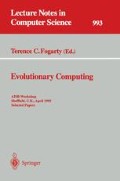Abstract
Models of adaptive behaviour are normally highly complex due to a greater emphasis on, learning by interaction with the environment, flexible behaviour, and, an evolutionary learning methodology. This research investigates how a combination of Genetic Algorithms and Neural Networks (GA+NN) can be used to model behaviour to solve a task requiring co-operation between two artificial autonomous agents. In particular, the results illustrate how a complex learning task (that is, a simple game of football which requires a highly dynamic interaction between agents and the environment) is learned more efficiently as a result of GA operator modifications and modularisation of the learning task. The overall effect of these changes is to constrain the search space that the hybrid GA+NN system can potentially explore. A distinction between task and search complexity provides a useful framework for a clearer comprehension of the nature of constraints vis-a-vis the modelling process (generally characterised as a complex adaptive system). Broad implications of the findings on modular models of adaptive behaviour and the role of constraints on complexity are briefly discussed.
Preview
Unable to display preview. Download preview PDF.
References
Beer, R. D., Gallagher, J. C.: Evolving dynamical neural networks for adaptive behavior. Adaptive behavior. 1(1) 91–122 (1992)
Beer. R.: A Dynamical Systems Perspective on Autonomous Agents. Case Western Reserve University Technical Report CES-92-11. Cleveland, Ohio. (1992)
Belew, R. K., McInerney, J., Schraudolph, N. N.: Evolving networks: Using genetic algorithms with connectionist learning. CSE technical report CS90-174, University of California at San Diego, CA. (1990)
Bersini, H., Seront, G.: In search of a good crossover between evolution and optimization. Parallel Problem Solving from Nature 2, B. Manderick, R. Manner (eds.) Amsterdam: Elsevier 479–488. (1992)
Davis, L. (ed.): Handbook of genetic algorithms. NY: Van Nostrand Reinhold (1991)
Dorigo, M.: ALECSYS and the AutonoMouse: Learning to Control a Real Robot by Distributed Classifier Systems. Machine Learning 19 (3) 209–240 (1995)
Dorigo, M., Colombetti M.: Robot Shaping: Developing Autonomous Agents through Learning. Artificial Intelligence 71 (2) 321–370 (1995)
Goldberg, D. E.: Genetic algorithms in search, optimisation and machine learning. Reading, MA:Addison-Wesley (1989)
Holland, J. H.: Adaption in natural and artificial systems. The University of Michigan Press, Ann Arbor, MI. (1975)
Koza, J. R.: Genetic Programming: A paradigm of genetically breeding computer population of computer programs to solve problems. Cambridge, MA: MIT Press (1992)
Kuscu, I., Thornton, C. Design of Artificial Neural Network Using Genetic Algorithms: review and prospect. Cognitive and Computing School Technical Report, University of Sussex, Falmer, England. (1994)
Langton, C., Taylor, C., Farmer, J., Rasmussen, S. (eds.): Proceedings of Artificial Life II. Santa Fe Institute Studies in the Sciences of Complexity, Vol 10. Redwood City, CA: Addison-Wesley (1991)
Meyer, J. A., Roitblat, H. L., Wilson, W. (eds.): From Animals to Animats. Proceedings of the Second International Conference on Simulation of Adaptive Behaviour. Cambridge, Mass: MIT Press. (1991)
Nicolis G., Prigogine I.: Exploring Complexity: An Introduction (1989)
Nolfi, S., Parisi, D.: Evolving Artificial Neural Networks that Develop in Time. In Advances in Artificial Life: Proceeding of ECAL 95, F. Moran, A. Moreno, J. J. Merelo and P. Chacon (eds.) Lecture Notes in Artificial Intelligence 929 Berlin: Springer-Verlag 353–367 (1995)
Patel, M. J.: Concept Formation: A Complex Adaptive Approach. Theoria, No 20 89–108, Universidad del Pais Vasco, San Sabastian, Spain. ISSN 0495-548 (1994a)
Patel, M. J.: Situation Assessment and Adaptive Learning: Theoretical and Experimental issues. In proceedings of the Second International Round-Table on Abstract Intelligent, Agent, Rome: ENEA Headquarters. And as ERCIM Research Report, ERCIM-03/94-R030 CNR, Rocquencourt, France (1994b)
Patel, M. J.: Advance Tutorial ou Hybrid Systems of Genetic Algorithms and Neural Networks (GA+NN). Mss copy available from author or anonymous ftp at ftp.cs.iastate.edu (pub/gann/papers/patel_tutorial_94.ps.Z) (1994c)
Patel, M. J.: An evaluation of the nature of representations in complex adaptive (learning) systems. Journal of Cognitive Systems, forthcoming (1995)
Patel, M. J., Schnepf, U.: Concept Formation as Emergent Phenomena. In Proceedings of the first, European Conference on Artificial Life, F. J. Varela, P. Bourgine (eds.), Cambridge, MA: MIT Press (1991)
Patel, M. J., Maniezzo, V.: NN's and GA's: Evolving co-operative behaviour in adaptive learning agents. In proceedings of the IEEE World Congress on Computational Intelligence: Evolutionary Computation, Orlando, Florida: IEEE Computers. (1994)
Patel, M. J., Dorigo, M.: Adaptive Learning of a Robot. In Selected papers from AISB Workshop on Evolutionary Computation (Leeds, UK), T. C. Fogerty (ed.). Lecture Notes in Computer Science 865, 180–194 Berlin: Springer-Verlag (1994)
Patel, M. J., Dorigo, M., Colombetti M.: Evolutionary Learning for Intelligent Automation: A Case Study. Journal of Intelligent, Automation and Soft Computing, 1 (1) 29–42 (1995)
Schaffer, J. D. Whitley, D. Eshelman, L. J.: Combinations of Genetic Algorithms and Neural Networks: A Survey of the State of the Art. Proc. Int. wks. on Combinations of Genetic Algorithms and Neural Networks (COGANN-92), (1992) 1–37.
van Gelder, T.: What might cognition be if not computation? University of Indianna Technical Report 75 (1992)
Yao, X.: A Review of Evolutionary Artificial Neural Networks. Tech. Rep. Commonwealth Scientific and Industrial Research Organization, Victoria, Australia (1992)
Author information
Authors and Affiliations
Editor information
Rights and permissions
Copyright information
© 1995 Springer-Verlag Berlin Heidelberg
About this paper
Cite this paper
Patel, M.J. (1995). Constraints on task and search complexity in GA+NN models of learning and adaptive behaviour. In: Fogarty, T.C. (eds) Evolutionary Computing. AISB EC 1995. Lecture Notes in Computer Science, vol 993. Springer, Berlin, Heidelberg. https://doi.org/10.1007/3-540-60469-3_36
Download citation
DOI: https://doi.org/10.1007/3-540-60469-3_36
Published:
Publisher Name: Springer, Berlin, Heidelberg
Print ISBN: 978-3-540-60469-3
Online ISBN: 978-3-540-47515-6
eBook Packages: Springer Book Archive

